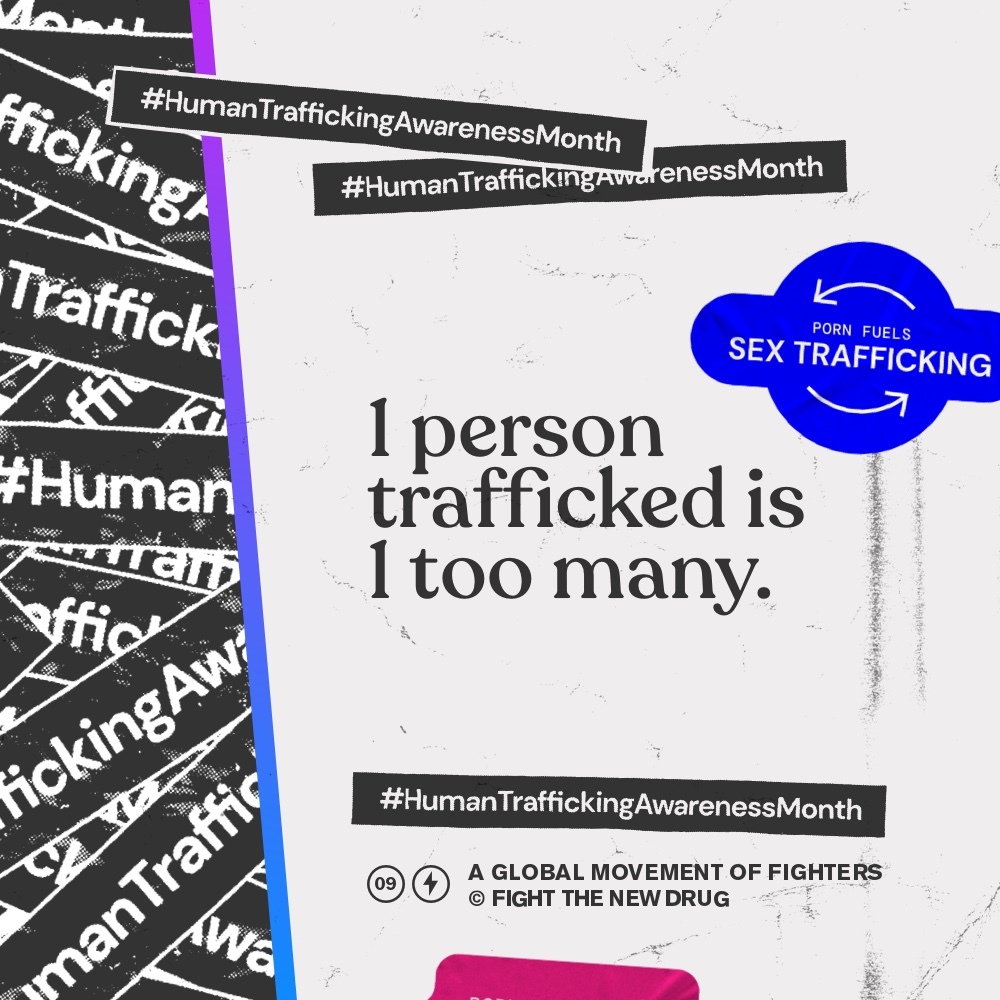Easier said than done, right? Human trafficking, child exploitation, and women’s organizations regularly campaign to stop the demand. Perhaps the most famous slogan is #RealMenDontBuyGirls (an unintentionally shaming phrase, we might add). Awareness is raised, minds are changed, but trafficking increases.
In an article, Dr. Gail Dines, President and CEO of the anti-porn organization Culture Reframed, commented:
“We know that trafficking is increasing, which means demand is increasing. This means that men are increasingly willing to have sex with women who are being controlled and abused by pimps and traffickers. There are only two conclusions here: That men are naturally willing to do this to women, or that they are being socialized by the culture to lose all empathy for women. I refuse to accept that men are born rapists, porn users, or [sex buyers].”
We agree. To assume this exploitative behavior is human nature is an injustice to men. So, how does a sex buyer get to the point where he can justify buying a teenage girl, whether he’s traveling to Thailand or 20 minutes from his house in the suburbs?
There are many steps to developing this process of thinking, but an often forgotten missing link is porn. The influence of porn in our culture is strong, although often overlooked. Young people are often educated about sex through porn, while adults’ search terms shape their views on sex, relationships, and objectification.
Of course, sex trafficking existed long before internet porn—technically, both pornographic depictions and sex trafficking go back to the beginnings of human civilization—but now is a unique point in time when there is more porn than ever, readily available for anyone.
Not every porn consumer buys sex from exploited individuals. However, the connection between pornography and sex trafficking is undeniable and crucial.
What is sex trafficking?
The Trafficking Victims Protection Act of 2000 was a significant move in US legislation that identified different forms of human trafficking, set harsh criminal penalties for offenders, and provided support for victims. It defines sex trafficking as a situation in which “a commercial sex act is induced by force, fraud, or coercion, or in which the person induced to perform such act has not attained 18 years of age.”
This definition allows for many different sex trafficking scenarios that may not get as much news coverage to be prosecuted. Those unfamiliar with this issue may imagine Hollywood situations, such as a girl or boy kidnapped in a foreign country, chained, and forced into prostitution. Or boys and girls from a foreign country smuggled into the US and similarly abused.
These stories do exist. They are real, but they aren’t the only scenarios.
Sex trafficking isn’t just some foreign country’s problem. It is every country’s problem. For example, one very real and common way teenage girls in Western countries are trafficked is through what is called the “boyfriend” method, in which the girl is groomed to believe she is in a loving and trusting relationship with a man who abuses her and sells her for sex.
Sex trafficking is truly a global problem, one we cannot afford to assume does not exist in our home cities.
The undeniable connection
Because of the variety of circumstances in which sex trafficking occurs, there are many contributing causes subject to differences in cultures, economies, political influences, and legislation, to name a few. For example, Europe has seen a rise in the sex trafficking of refugees, whereas the child sex trafficking industry has grown in the Philippines.
Issues of poverty and power commonly intertwine in sex trafficking, not to mention porn.
It’s a contentious topic, but growing research points to porn as a significant factor in fueling this issue.
How porn affects the supply and demand for exploitation
Porn directly influences the supply and demand for sex trafficking. Studies have shown that exposure to porn can make a person less compassionate toward victims of sexual violence and exploitation, and consuming porn can increase a consumer’s desire to seek out and perform their fantasies by purchasing sex.
Building on the consumer’s desire to act out what they’ve seen is the “training manual” connection, in which sex buyers have the person they’re purchasing sex from watch a video in preparation for a reenactment to fulfill porn-inspired fantasies. Ultimately a porn director’s fantasy becomes the reality of someone selling sex.
Of course, not only does porn influence the demand and behavior of sex trafficking and the purchase of commercial sex, the sad fact is that sometimes porn is a record that sex trafficking took place.
Sometimes, they’re one and the same
The National Human Trafficking Hotline listed the top venues in 2018 where sex trafficking occurred. In order, they included illicit massage/spa business, residence-based commercial sex, hotel/motel-based, pornography, and online ads.
Most of these locations aren’t a surprise, but pornography?
Perhaps because of the prevalence of porn in our society, whether or not we want to acknowledge it, we are inclined to think what people watch is recorded sex acts between consenting adults. Sometimes it’s distinguishable, but often it’s difficult to tell the difference between the two.
According to anti-trafficking nonprofit Rescue: Freedom, in 9 countries, 49% of sexually exploited women said that pornography was made of them while they were being sold for sex. One female survivor, whose captor slept on top of her at night to prevent her escape, watched her through a hole when she went to the bathroom and listened to her phone calls with a gun pointed at her head, was forced to appear in a porn video. Later, the film made the Sinclair Intimacy Institute’s list of “sex-positive productions,” but this woman knew the truth.
In 2020, over a dozen women sued the porn company “GirlsDoPorn” for tricking, forcing, and coercing them to shoot sex on camera. The videos they were forced to appear in ended up on mainstream porn sites despite the footage actually being of sex trafficking, not a consensual porn shoot.
While many porn performers report having positive experiences on set, this isn’t a universal response. In Florida, two men lured women with modeling auditions, drugged them, filmed the assaults, and sold the footage as online porn. Even in professional porn, there are allegations of abuse and coercion, falling under the TVPA’s definition of sex trafficking.
Consider that even performers’ expressed consent in post-shoot exit interviews is not always truthful because performers are massively pressured into not reporting abuse. We cannot emphasize this enough: even a mainstream, professional porn performer’s consent can be violated during a shoot or coerced into doing sex acts they are not comfortable with, and the viewer would never realize they’re consuming images of exploitation.
We are not claiming that all porn is non-consensual. We’re raising awareness that there is no way to tell if the porn a consumer views is completely consensual or produced without any coercion.
Consider all the facts before consuming
There is no easy call to action to end sex trafficking. Tackling this demands global government support to enforce laws and protect the vulnerable, which is just a starting point.
How do you kill an industry? If no one wants to buy a product, it doesn’t sell. Stopping the demand for sex trafficking starts with each one of us. If the horror of sex trafficking shocks you, reflect on what millions consume daily.
Was that so-called “sex-positive” video completely consensual and exploitation-free? What do those violent images of sex suggest or normalize, including in the trafficking world? Do those videos encourage objectification and sexualization of teen girls and minor exploitation?
And ultimately, does porn drive the demand for sex trafficking? Hopefully, now you know the answer.

Your Support Matters Now More Than Ever
Most kids today are exposed to porn by the age of 12. By the time they’re teenagers, 75% of boys and 70% of girls have already viewed itRobb, M.B., & Mann, S. (2023). Teens and pornography. San Francisco, CA: Common Sense.Copy —often before they’ve had a single healthy conversation about it.
Even more concerning: over half of boys and nearly 40% of girls believe porn is a realistic depiction of sexMartellozzo, E., Monaghan, A., Adler, J. R., Davidson, J., Leyva, R., & Horvath, M. A. H. (2016). “I wasn’t sure it was normal to watch it”: A quantitative and qualitative examination of the impact of online pornography on the values, attitudes, beliefs and behaviours of children and young people. Middlesex University, NSPCC, & Office of the Children’s Commissioner.Copy . And among teens who have seen porn, more than 79% of teens use it to learn how to have sexRobb, M.B., & Mann, S. (2023). Teens and pornography. San Francisco, CA: Common Sense.Copy . That means millions of young people are getting sex ed from violent, degrading content, which becomes their baseline understanding of intimacy. Out of the most popular porn, 33%-88% of videos contain physical aggression and nonconsensual violence-related themesFritz, N., Malic, V., Paul, B., & Zhou, Y. (2020). A descriptive analysis of the types, targets, and relative frequency of aggression in mainstream pornography. Archives of Sexual Behavior, 49(8), 3041-3053. doi:10.1007/s10508-020-01773-0Copy Bridges et al., 2010, “Aggression and Sexual Behavior in Best-Selling Pornography Videos: A Content Analysis,” Violence Against Women.Copy .
From increasing rates of loneliness, depression, and self-doubt, to distorted views of sex, reduced relationship satisfaction, and riskier sexual behavior among teens, porn is impacting individuals, relationships, and society worldwideFight the New Drug. (2024, May). Get the Facts (Series of web articles). Fight the New Drug.Copy .
This is why Fight the New Drug exists—but we can’t do it without you.
Your donation directly fuels the creation of new educational resources, including our awareness-raising videos, podcasts, research-driven articles, engaging school presentations, and digital tools that reach youth where they are: online and in school. It equips individuals, parents, educators, and youth with trustworthy resources to start the conversation.
Will you join us? We’re grateful for whatever you can give—but a recurring donation makes the biggest difference. Every dollar directly supports our vital work, and every individual we reach decreases sexual exploitation. Let’s fight for real love:






